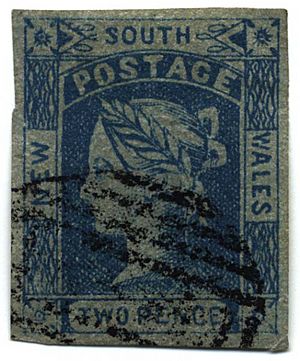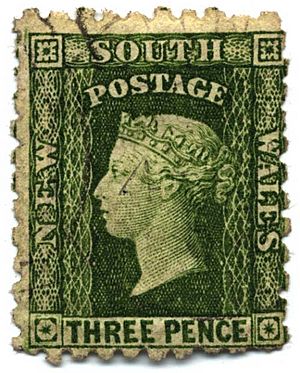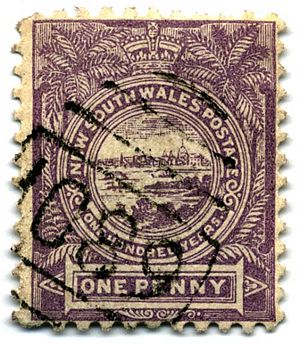Postage stamps and postal history of New South Wales facts for kids
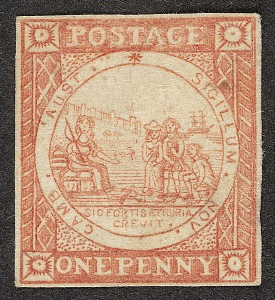
Have you ever wondered about old stamps? This article explores the postage stamps and postal history of New South Wales. New South Wales was once a British colony and is now a state in Australia. You'll learn how mail was sent and how stamps changed over time.
Contents
Early Mail in New South Wales
How Mail Started in NSW
New South Wales was the first part of Australia where Europeans settled. It was also the first to have a postal service. In 1803, letters could be sent between Sydney and Parramatta for just two pence.
By 1809, Sydney had an office to collect mail from ships. The postal service grew bigger in 1825. Mail coaches, like horse-drawn buses, started delivering mail in 1830.
New Rules for Sending Mail
In 1835, a new law called the Postage Act changed how much mail cost. The price depended on how heavy the letter was and how far it traveled.
James Raymond, the postmaster, wanted people to pay for letters before sending them. In 1838, he introduced special envelopes. These envelopes had the colony's seal pressed into them. They cost less than paying cash for local mail. These envelopes were like early versions of the famous Penny Black stamp. But people did not use them much.
New South Wales' First Stamps
The "Sydney Views" Stamps
By 1842, steamboats carried mail regularly between Melbourne and Sydney. The first mail packet from Britain arrived in 1844. A new law in 1848 allowed the use of stamps.
The very first stamps appeared on January 1, 1850. They were made in New South Wales. These stamps showed a picture of Sydney and its harbor. Because of this, they became known as the "Sydney Views." There were 1d, 2d, and 3d stamps. They were re-engraved many times, creating many different types.
Queen Victoria Stamps
In 1851, the colony started using a more common stamp design. It showed a side view of Queen Victoria wearing a laurel wreath. The first version was a bit rough, but a better one came out in 1853.
New South Wales did something unusual with its stamp paper. The paper had a watermark showing the stamp's value. Sometimes, the watermark did not match the printed value. These mismatched stamps are very rare and valuable today.
Larger and Perforated Stamps
In 1854, New South Wales issued 6d and 1/- stamps. These were printed locally. They were large, square stamps showing Queen Victoria wearing a diadem. The 6d stamp had a hexagon shape around her, and the 1/- had an octagon. These designs were also used for 5d and 8d stamps in 1855.
By 1856, these designs were used for lower value stamps too. The ink used varied a lot, leading to many different color shades. In 1860, stamps started to have perforations, which are the small holes that help you tear stamps apart. However, the stamps were printed very close together. This often meant the perforations cut into the stamp's design.
The first 5-shilling stamp came out in 1861. It was special because it was round, like a medal. New designs were also created in 1861 by De La Rue. These were printed both in London and in the colony.
Special Stamp Features
In 1871, a new watermark was used. It said "NSW" with a crown above it. By 1885, there was a need for high-value stamps. So, existing revenue stamps (used for taxes) were overprinted with "POSTAGE" to make them postage stamps.
New South Wales celebrated its 100th birthday in 1888. They released what many consider the first commemorative stamps. This set of eight stamps each had a different design. They all said "ONE HUNDRED YEARS." Designs included a view of Sydney, an emu, Captain Cook, a lyrebird, and a kangaroo. The 20/- stamp showed both Arthur Phillip, the first governor, and Lord Carrington, the governor at the time.
In 1890, a 2½d stamp showed a figure representing Australia. In 1891, some existing stamps had new values printed over them, like ½d, 7½d, and 12½d.
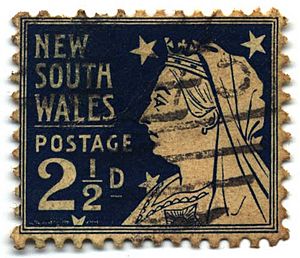
In 1897, two early semi-postal stamps were issued. These stamps paid for postage but were sold for more money. The extra money went to a hospital for people with lung diseases. In the same year, three stamps marked Queen Victoria's Diamond Jubilee (60 years as queen).
Stamps Join the Commonwealth
When Australia became a Commonwealth (a group of states working together), it did not immediately change the NSW postal system. The new constitution gave the Commonwealth power over mail. But the systems slowly joined together during the 1900s.
In 1903, a 9d stamp was issued. It was printed in two colors and said "COMMONWEALTH." It also listed the initials of each member state and their founding year. By 1905, stamps were printed on paper with a crown and the letter "A" as a watermark. Existing designs continued to be reprinted until 1910.
In 1913, the stamps of New South Wales were replaced by the new stamps of Australia. To learn more, see Postage stamps and postal history of Australia.
Collecting New South Wales stamps can be complex. There are many types of watermarks, different perforations, and various color shades. Stamp catalogs like the Scott catalogue and Stanley Gibbons catalog list hundreds of different varieties.
Numeral Cancellations
What are Numeral Cancellations?
Stamp collectors are also interested in "numeral cancellations." These are numbers stamped onto postage stamps to cancel them. This means the stamp cannot be used again.
When the first stamps came out in 1850, 96 post offices already existed. Each office was given a number to cancel stamps. Sydney itself did not have a number. It used special "dumb" (meaning no number) cancellers. The first numbers were given out based on roads leading out from Sydney.
Tracking History with Numbers
More numbers were given to new post offices until 1904. The way these numbers were given out helps track how the state was settled. However, it can be tricky. Numbers were sometimes changed when post offices closed or when areas became new colonies, like Queensland.
Larger post offices also stamped the date and the office name on the mail. This helps connect numbers to specific post offices, even if official records are missing. Still, about 300 New South Wales numbers are still a mystery.
Numeral cancellations come in many forms. Early ones had horizontal bars. Later ones had "ray" patterns. The color of the ink could also change. Collectors of numeral cancellations often focus on the mark itself, not how the stamp looks.
Postal Stationery
Pre-printed Mail Items
New South Wales also produced its own Postal stationery. This means items like envelopes or postcards that already had the postage printed on them. This continued until Australia's Commonwealth stationery became available in 1911.
Envelopes were first issued in 1838 for local mail in Sydney. They were used until 1857. Between 1870 and 1911, eleven different envelopes were made. Registration envelopes, used for sending important mail, became available in 1880. A total of 14 different types were produced.
Newspaper wrappers, used for mailing newspapers, were available from 1864. New South Wales was one of the first places to issue these. Twelve different wrappers are known. Letter cards, which were like folded postcards, were used from 1894. Eleven different letter cards were made. Postcards were available from 1875. By the time Australian Commonwealth postcards were introduced, New South Wales had made 34 different postcards.


